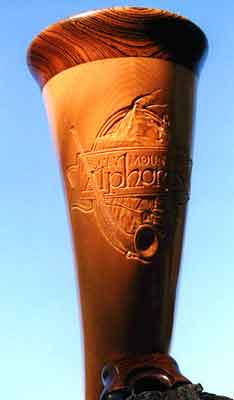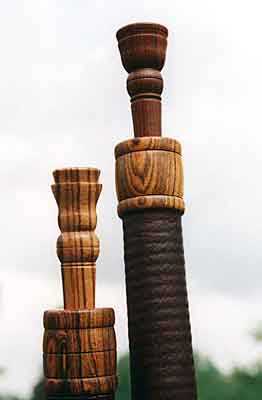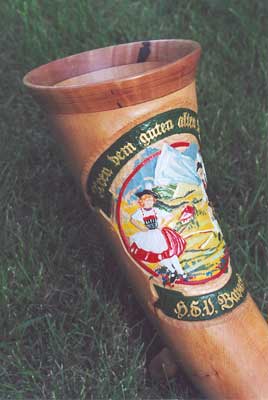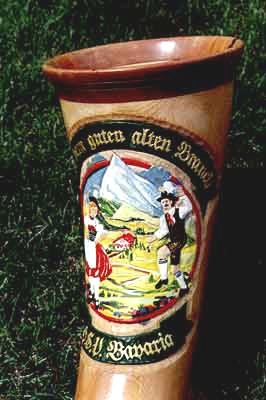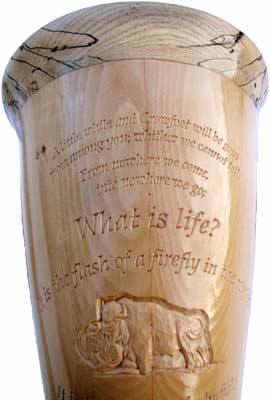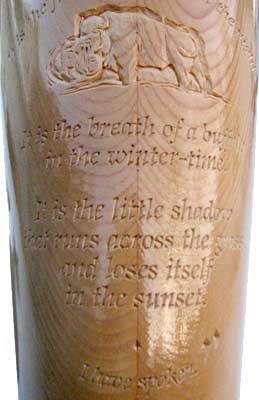Alphorn #3:
The artwork applied to Rocky Mountain Alphorns, as a matter of general principal, features North American scenes and North American flora and fauna. For the Alphorn on the left we made an exception because this Alphorn was commissioned by a member of the Matterhorn Alphorn Duo. The white flower featured is Edelweiss, a native to the Alps. The season here is Midsummer, which is flower season in the alpine regions. Mount Assinibone bears such a remarkable resemblance to the Swiss Matterhorn that it is sometimes referred to as "The Matterhorn of the Rockies". In this case the identity of the mountain is in the eyes of the beholder.
The addition to the price of an Alphorn for this artwork is $330.00 U.S. or $330.00 Canadian.
The bell art on the Alphorn on the right features North American wildflowers in place of the Edelweiss. The other flowers are native to both mountain ranges.
The addition to the price of an Alphorn for this artwork is $330.00 U.S. or $330.00 Canadian.
Mount Assiniboine in the summer has proved has proved to be a very popular artwork subject for Alphorn purchasers. Although Doug Pauls has decorated many Rocky Mountain Alphorn bells with this subject, the variety of flowers native to this area has assured that each one is unique.
|
Alphorn #4:
This woodcarving on this Alphorn features two Ruby Throated Hummingbirds (male and female) hovering and feeding in a patch of Wiegala flowers. This artwork is a commission from a Hummingbird lover in Michigan. It is, in my opinion, some of the most beautiful artwork Doug has ever done. |  |
Alphorn #5:
The artwork on this Alphorn has the historical image of a medallion presented to the best Alphorn player at the first alpine shepherds' festival held in Unspunnen (Switzerland) in 1805. This shortened version of the Alphorn is known in Switzerland as an Unspunnenhorn. The inscription, "ZUR EHRE DES ALPHORNS", translates as "In Praise of the Alphorn" in Swiss dialect.
The quiet dignity of the presentation, and the historical importance of the subject have made this an easy choice for many Alphorn purchasers. Of course, the Rocky Mountain Alphorns banner was not a part of the original medallion. At the option of the purchaser it may be eliminated for historical accuracy.
The addition to the price of an Alphorn for this artwork is $240.00 U.S. or $240.00 Canadian.
Alphorn #6 (above and below):
This Alphorn features wood trim elements (bell ring, collar, foot and mouthpiece receiver knob) made from Koa Wood, a beautiful and exotic hardwood from the upper forests of the Hawaiian Islands. Koa is well regarded for its sounding properties, and is the wood of choice for the finest Hawaiian Ukeleles. When the Koa is first cut, it is a bright red, but with exposure to the air the iron content of the wood oxidizes (in effect, rusts) to a deep orange.
In addition, this Alphorn is extensively carved by my artist Doug Pauls with scenes from Swiss alpine folklore, as you can see in the following photographs.
Doug's carving on the top of this horn is inspired by a famous Swiss lithograph portraying the twilight ritual blowing of the Alphorn. The Alphorn blower is at the edge of a cliff overlooking his village. It can be presumed that he is sounding his valley's traditional "All is Well" signal to the last light of the setting sun. His friend takes in the scene, lying on his stomach and smoking a pipe while various farm animals graze contentedly nearby.
The Horn that the herdsman is blowing is of a shorter length. This is an earlier version of the Alphorn known in Switzerland as an Unspunnenhorn (see the image and explanation in Alphorn #5 above). In many historical images the instrument is played in this bell-up position. The reasonable explanation for this is simply that artists find the upright pose to be dramatic.
The scene carved into the bottom of this horn describes the role of the Alphorn in the daily life of a typical Swiss dairy farm in years gone by. The Alphorn blower at the top of the cliff plays for the cows at milking time. Man's best friend wags his tail at the Alphorn blower's side. A Swiss maid is milking a cow at the base of the cliff as a line of cows approaches down a steep mountain path. Over many years the cows have been conditioned to let down their milk at the sounding of the Alphorn. Their udders are slowly filling as the Alphorn calls them to take their nightly turn at the milk pail. 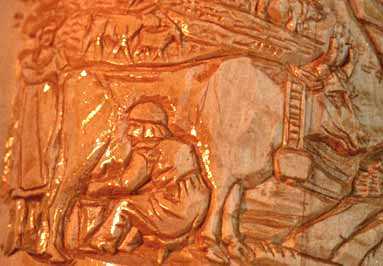 In just a few photographs it is impossible to reveal all of the marvelous detail that Doug has carved into this Alphorn.
In just a few photographs it is impossible to reveal all of the marvelous detail that Doug has carved into this Alphorn.
The addition to the price of an Alphorn for this carved bell artwork by Doug Pauls is:
- Top: $330.00 U.S. or $330.00 Canadian
- Bottom: $330.00 U.S. or $330.00 Canadian
Both carvings are available on the top or bottom; together or separately.
This bell artwork is my sentimental favorite of all of Doug's works. This Alphorn is in my personal collection and is my instrument of choice for performances. It differs from my other Alphorns in that the body of this instrument is made from Yellow Cedar, another much admired tonewood from British Columbia. I may someday offer Alphorns made from Yellow Cedar if I can locate a supply of wood stock, but in direct comparison I can see no tonal advantage in Yellow Cedar over the fine Sitka Spruce that I currently use in Alphorn production.
Alphorn #7 (above and below):
The bell ring, collar, foot and mouthpiece receiver knob on this Alphorn are made from Bocote, a valuable and exotic hardwood from Mexico.
For any Alphorn purchaser who desires a horn of surpassing beauty, I can offer an Alphorn with such highlights made from several exotic hardwoods, as well as the Bocote featured here. The exact woods that I can offer depend upon current supply and availability, and are listed at the top of this page.
Doug has carved the top of the bell with the medallion image as in Alphorn #5, but without the Rocky Mountain Alphorns banner. The bottom of the bell features a carving of Mount Assiniboine with my Rocky Mountain Alphorns banner. The artwork on this Alphorn is unpainted to draw all attention to the beauty of the Bocote woodwork.
The addition to the price of an Alphorn for this carved bell artwork by Doug Pauls is:
- Top: $240.00 U.S. or $240.00 Canadian
- Bottom: $275.00 U.S. or $275.00 Canadian
Both carvings are available on the top or bottom; together or separately.
|
Alphorn #8:
A customer in Zurich, Switzerland, wanted the coat of arms of that ancient city. The lion is in gold leaf, and the sword and shield are in silver leaf.
|  |
Alphorn #9:
The artwork on this Alphorn was commissioned by H. S. V. Bavaria, a schuhplattler dancing group. Schuhplattler is a very energetic form of dancing, which gets its name from the way the men give enthusiastic slaps to their shoes (and thighs) as they leap through the air. The image carved and painted on this Alphorn demonstrates this dance. The lady is wearing her traditional Dirndl, and the gentleman his Lederhosen, which in practice is generally worn smooth on the upper thighs by the repeated slapping that it endures over many years. Located in Connecticut, U. S. A., the fine people of H. S. V. Bavaria have a wonderful time keeping the traditions of their homeland alive.
|
Alphorn #10:
This woodcarving on this Alphorn features the fierce and noble mien of a Mountain Ram glaring haughtily at the viewer. The artwork is unpainted because the wood grain is a natural part of the presentation. The addition to the price of an Alphorn for this artwork is $240.00 U.S. or $240.00 Canadian.
| 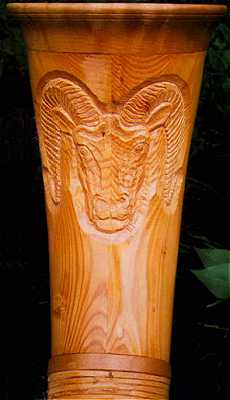 |
|
Alphorn #11:
A favorite passion of this customer is fly fishing (which is true of William Hopson as well). This is a classic Rocky Mountain fly fishing scene. The leaping trout is a Cut-throat Trout, which has risen to a dry fly. A desperate fight will ensue, but afterwards the fish will be released. Cut-throat Trout are native to the alpine lakes. In the background is Mount Assiniboine, which makes the lake either Sunburst Lake or Lake Magog, both of which are noted for spectacular fishing. | 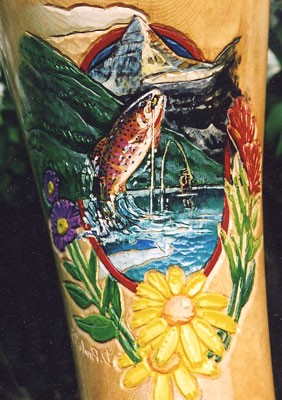 |
|
Alphorn #12:
This customer wanted an image of his ancestral home in Switzerland, and his family coat of arms. Note the fine Cocobolo bell ring.
| 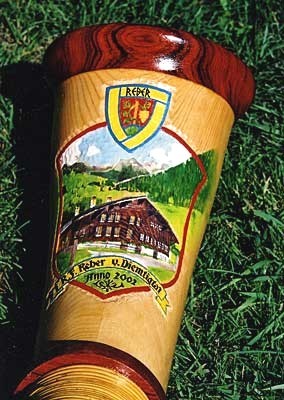 |
|
Alphorn #13:
A customer in Alaska wanted an image of his favorite hiking area, in this case "Seven Peaks" and the "Robertson Glacier". He also requested the Black Bear and the Bald Eagle. | 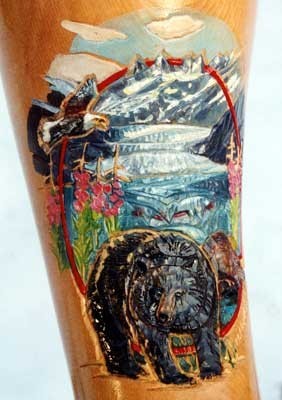 |
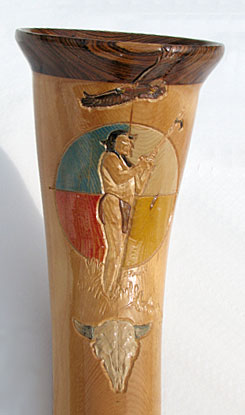 |  |
| Praying to the Elders | Tatanka Iyotaka (Sitting Bull) |
Alphorn #14:
This Alphorn artwork is very special to Doug Pauls. Doug is very involved in the Native American culture in Alberta, Canada. Doug had an idea to do an Alphorn on an Native American theme, and this is the wonderful result.
The artwork on the left is inspired in part by a photograph by Edward S. Curtis, an early photographer of the North American Indian culture.
The man is praying with his pipe. He is asking for the help of his elders, and thus his prayer will traditionally begin with "All My Relations". The four coloured fields represent the four directions.
This is a part of the native ceremony of the Sweat Lodge, which is very important in Sioux tradition. The Golden Eagle and the Buffalo (Bison) skull are important symbols in the native culture.
The artwork on the right is Doug's vision of the great Tatanka Iyotaka (circa 1831 - 1890), a Chief and Medicine Man of the Hunkpapa Sioux known more commonly as Sitting Bull. Sitting Bull was possibly born in Canada, but spent most of his life on the United States side of the border leading his people through very difficult times as the powerful white culture drove the Sioux tribes from their traditional lands and eventually forced the Sioux to live on inadequate reservations. Sitting Bull was a heroic defender of his people, and a man of great dignity, intelligence and strength. He was the last Sioux Chief to lay down his rifle in resistance to the armed subjugation of his race.
|
Alphorn #15:
A customer in Washington State, as a birthday gift for his wife, wanted an Alphorn with an artistic depiction of Mount Ranier, which is their favorite hiking area. He also requested the Paint Brush flowers in the colour local to the area. Other than that he gave Doug Pauls free reign to use his imagination, and this is the wonderful result. | 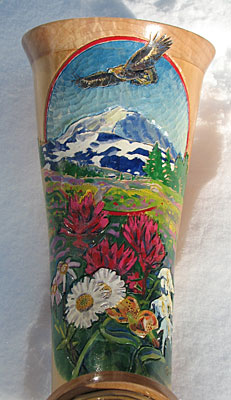 |
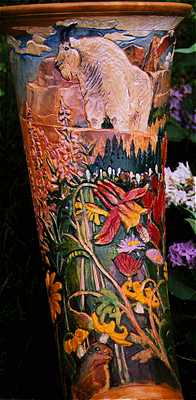 | 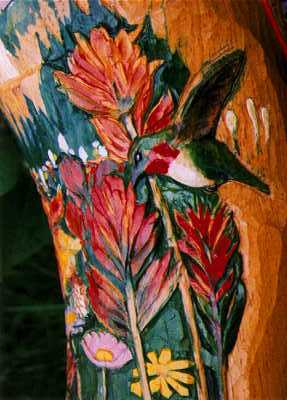 |
| Mountain Goat | Hummingbird Detail |
Alphorn #16:
This Alphorn is extensively carved and painted. It features a Mountain Goat on a rock and alpine wildflowers (visited by a ruby-throated hummingbird), with the imposing background of Castle Mountain in
Banff National Park.
A ground squirrel peeks out from among the flowers and an eagle soars above the scene.
This is the first Alphorn that Doug carved and painted for Rocky Mountain Alphorns - sometime around 1990.
Alphorn #17:
This Alphorn features artwork very personal to Doug Pauls, who is involved in the Native American culture in Alberta, Canada. The subject of the artwork is Crowfoot, Chief of the Siksika Nation of the Blackfoot Tribe of Native Americans, whose land is near Calgary, Alberta, Canada.
As a young warrior Crowfoot fought in as many as 19 battles and sustained many injuries. Despite this, in his later years he sought peace among his native people in a time of much inter-tribal warfare.
When the Canadian Pacific Railway sought to build their mainline through Blackfoot territory, negotiations with the white people convinced Crowfoot that it should be allowed.
Although life in accomodation with the white people was not easy, this difficult decision proved to be the best for his people. At this time there were terrible wars in the United States between the white people and the Sioux Tribes led by Chief Sitting Bull. Chief Crowfoot's wisdom is one of the reason why wars like this were avoided in Canada.
The inscription below the image of Crowfoot is as follows:
Crowfoot
Siksika Blackfoot Chief
1830-1890
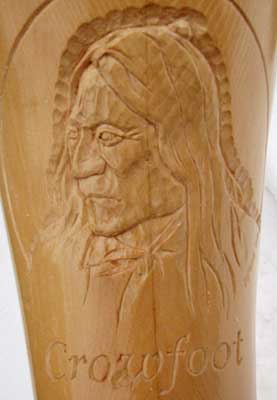 |  |
The artwork on the bottom of this Alphorn inscribes some of the words of Crowfoot and gives us an insight into his wisdom and his respect for nature.
The words inscribed on the Alphorn are:
"A little while and Crowfoot will be gone from among you, whither we cannot tell. From nowhere we come, and into nowhere we go.
What is life?
It is the flash of a firefly in the night. It is the breath of the buffalo in the winter-time. It is the shadow that runs across the grass and loses itself in the sunset.
I have spoken."
On this Alphorn the wood trim elements (bell ring, collar, foot and mouthpiece receiver knob) are made from Spalted Maple. This Maple is from Eastern Canada.
Spalted Maple typically has the "classic black-line" spalting that is produced by a fungus that grows in the wood soon after the tree is felled. The wood must be dried at just the right time for the spalting to be preserved in the wood, but before the fungus destroys the integrity of the wood. Spalted wood is highly prized by woodworkers. This is a fine example of wood spalting.
This Alphorn is in my personal collection and is my instrument of choice for performances in Western North America.
|
Alphorn #18:
Last, and anything but least, a customer who lived in Oregon at the time of the Mount St. Helens volcanic eruption wanted to commemorate that event. Here is the result; an example of a subject that demanded that Doug go "over the top".
| 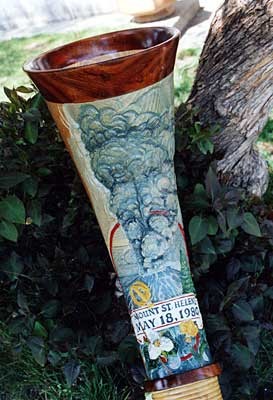 |
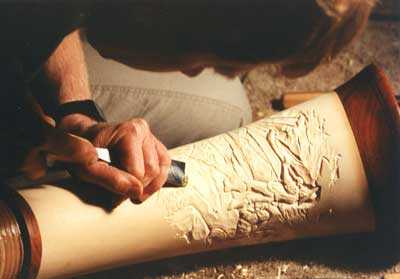 Each individual work of Doug's Alphorn artwork may involve 20 to 30 additional hours of work, and only a limited number will be available. The addition to the price of the Alphorn for Doug's artwork is listed below, and this entire fee goes to pay Doug for his inspired artwork. Doug works on these projects in the order that the Alphorn reservations are received. This is another reason to make your Alphorn reservation as early as possible.
Each individual work of Doug's Alphorn artwork may involve 20 to 30 additional hours of work, and only a limited number will be available. The addition to the price of the Alphorn for Doug's artwork is listed below, and this entire fee goes to pay Doug for his inspired artwork. Doug works on these projects in the order that the Alphorn reservations are received. This is another reason to make your Alphorn reservation as early as possible.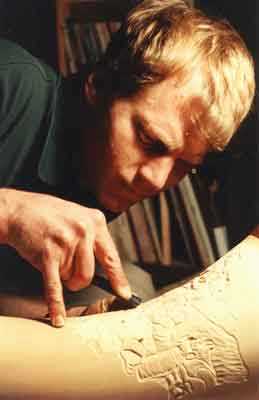

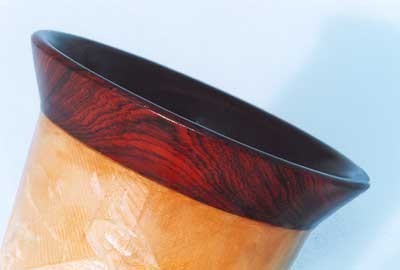

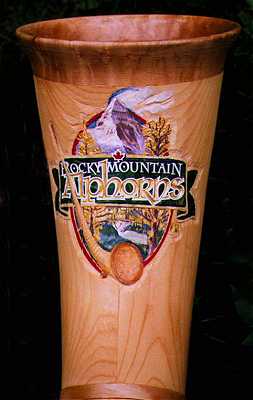
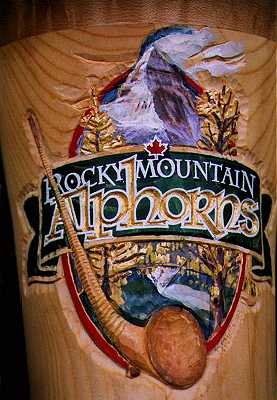
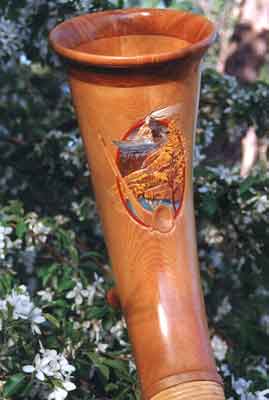
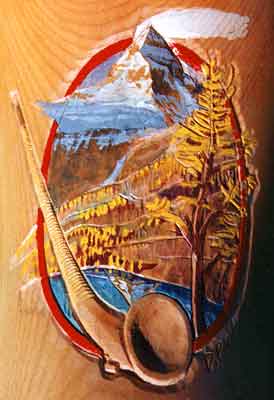
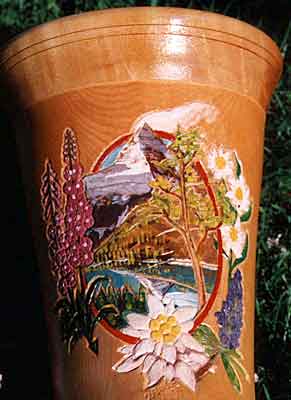
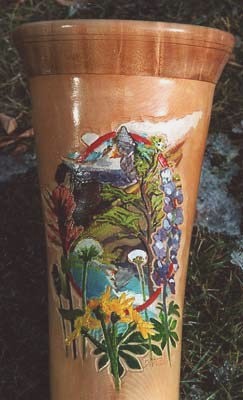

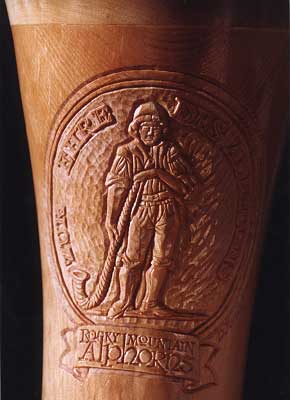
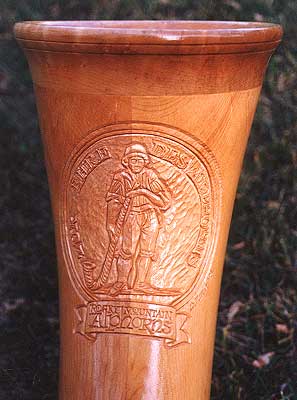
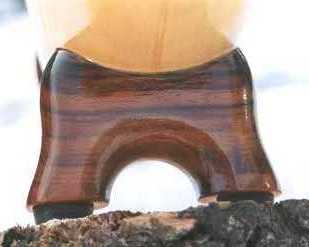
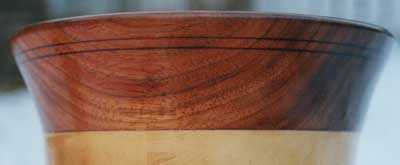
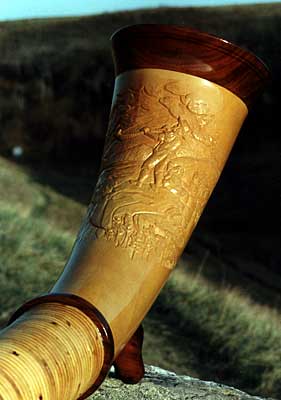
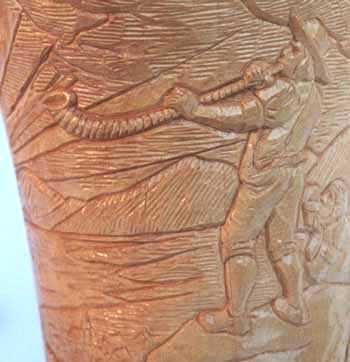
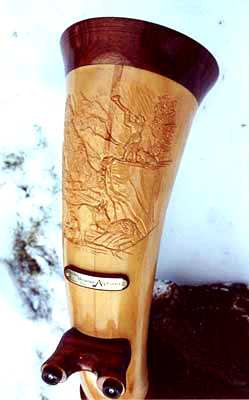
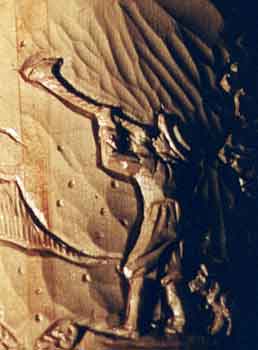
 In just a few photographs it is impossible to reveal all of the marvelous detail that Doug has carved into this Alphorn.
In just a few photographs it is impossible to reveal all of the marvelous detail that Doug has carved into this Alphorn.
